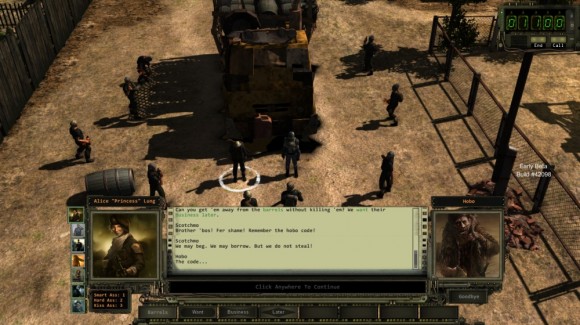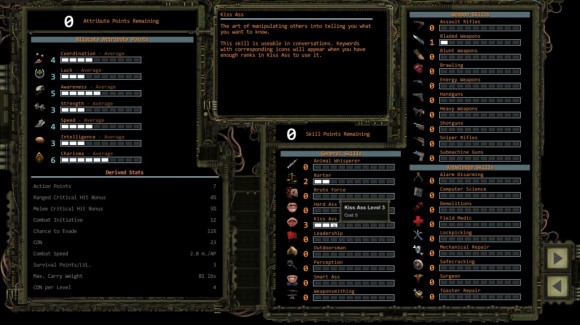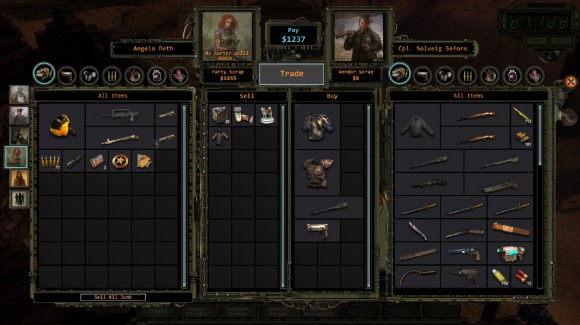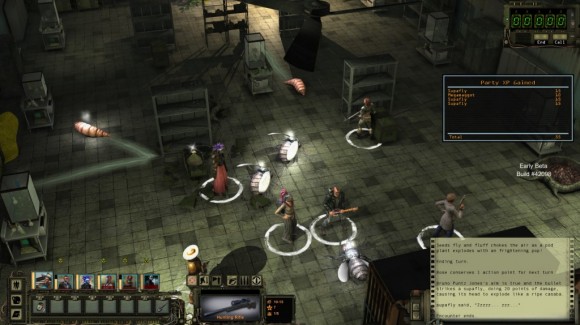Wasteland 2 is the a sequel to Wasteland, the game upon which the Fallout franchise is based. The creator of both franchises, Brian Fargo spent his years after leaving Interplay making games to keep the small company he and Matthew Findley founded afloat. During this time he also tried to make a spiritual successor to the Fallout franchise by doing a sequel to the game that spawned it: Wasteland 2. Despite a rocky start, the project would eventually be funded in 2012 when a Kickstarter effort raised over three times its requested amount of funding. A great story, to be sure, but the ending can only really be determined by the quality of the finished product. Fortunately, the finished product is one of the best games I’ve played this year.
Wasteland 2 tells the story of the Rangers, a former group of army engineers that was stationed in the Arizona desert when a nuclear apocalypse devastated the world. Wasteland 2 takes place 15 years after the original game, and is a canonical follow up. Those who have played the previous entry in the series will find numerous references and easter-eggs but newcomers will also be able to play without any real repercussions. The story starts simply enough; you finds yourself with a batch of fresh ranger recruits tasked with solving the murder of a ranger, and completing his mission if possible. The initial game may feel a bit linear at first but after the first few initial quests it opens up quite a bit.
When the game begins you will need to create your initial team of four rangers. You can choose from a line up of pre-made characters, create your own, or do a combination of custom and existing ones. Whatever options you choose, the character creation and management process is crucial. There is something of an art to creating a team that will be able to successfully tackle all the challenges in the game. Trying to make a character a “jack of all trades” will oftentimes make them useless instead, you will simply not be able to upgrade skills enough so that they are capable as the game progresses. Likewise, having a team with characters that are too specialized will cause you to miss opportunities, as there are safes to crack, locks to open, computers to hack, machines to repair, situations to talk your way out of and, of course, fights to win.
Forethought is also required when dealing with character advancement. You can train any character in any skill, but again, doing so with no care can have some severe consequences to your party down the line. It can seem overwhelming at first, specially since there are so many customization options available to the characters you create. You can choose their display model and portrait, you can write a short bio for them if you want, you can even choose what their favorite brand of cigarette is. This can all seem daunting at first, particularly if you haven’t played games with similar systems (GURPs or SPECIAL for example), but once you spend some time with the system it is easy to find the combinations that can help you succeed. If you do want more guidance, you can obtain a copy of the game manual in the game page on Steam, or by clicking here.
The world is laid out into two broad parts: the overworld map, where you can travel from one location to another, and the smaller maps that represent these locations. In the overworld map you will see a marker representing your group as they move across the Arizona desert. Here you can find secret locations, random encounters, or watering holes. Water management is crucial in this phase, as you have to make sure your rangers stay hydrated. If they run out of water, they will start losing health and eventually die. The random encounters usually give you a choice of fighting a band of raiders, or trying to go through an outdoorsman check to try to get away. If you do not get away, you will be pulled into a small map for combat. There are a variety of maps, but as the game goes on, they do start to repeat themselves. It is not a big deal during random encounters, but it is there.
Once you get to a location, you will enter its location map. These areas are where the real gameplay takes place. As is expected of an RPG, there is a great variety of location, from dungeons, to towns, to places with a lot to discover. There is a lot to find in these places, hidden rooms, items, and loot are all plentiful. The numerous paths and options available make exploration rewarding and gives the player a sense that they are part of a larger world. It also adds some replay value to the game. Didn’t have a hacker? It might be worth making a new team with different skills to access new areas of the game.
Combat works in a turned based skill point system, with some modifiers applied for positioning. The UI during combat is similar to that of the modern XCOM games. Making sure your rangers are in cover, and able to flank and out maneuver enemies is vital to successfully surviving encounters. Wasteland 2 rewards careful planning and a defensive disposition. Even in random encounters, the game will punish carelessness. Your grasp of tactics, and a little luck, can make the difference between having an easy time or harrowing battle that starts by being stabbed in the face.
Wasteland 2 does a great job of drawing you into its world, and it does that in part by making your actions, and sometimes inaction, have consequences. Even with the water managing mechanic, the raiders, and the irradiated areas, the game will give you the freedom to go where you want. This is provided that you are willing to face the consequences for it. You can easily get caught in an area where a lack of access to water, or the level of the enemies will ensure your demise. Make sure you have different saves. Inaction can also have consequences. If you ignore those who need your assistance for too long, then you will get radio messages informing you that the situation is deteriorating, or you may lose them altogether. This did not feel very restrictive, but it did go a long way to make the world feel alive and to show that it moves at its own pace, not yours.
Wasteland 2 is the kind of game that makes the hours melt away as you are playing it. It provides a great post-apocalyptic RPG experience that is a prime example of how to blend old-school design philosophies with modern technology. It is challenging, rewarding, and has solid mechanics. The great presentation and music bring it all together to create one of the best RPG’s I’ve played this year, and the kind of post apocalyptic RPG that I did not think I would get the chance to play again. I won’t claim it is perfect. I recognize that there are design decisions that I liked that will turn some people off. It will certainly not appeal to everyone, but it more than succeeded in its task to bring a modern take on the old turn based RPGs. I give this game a hearty recommendation, and I cannot wait to see what else InXile can bring to the table not that they seem to have found a funding model that allows for their creative freedom.
This review was done on early access/backer code provided by InXile Entertainment










